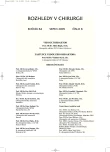Initial Experience with the Use of Fibrin Sealant for the Fixation of the Prosthetic Mesh in Laparoscopic Transabdominal Preperitoneal Hernia Repair
Počáteční zkušenosti s použitím fibrinového tmelu k fixaci protetické síťky u laparoskopické transabdominální reparace preperitoneální hernie
Úvod:
Výhodou laparoskopické operace inguinální hernie je rychlejší uzdravení a méně bolesti, než jak je tomu u klasického otevřeného přístupu. Na druhé straně, hlášená incidence poranění nervů plexus lumbalis s následnou chronickou bolestí nebo neuralgií je u laparoskopického přístupu 2 %, zvláště v případech, kdy se používá transabdominální preperitoneální technika (TAPP). Tyto komplikace jsou spojeny s používáním svorek k fixaci síťky. Aby se předešlo iritaci nervů, uvažovali jsme o tom, že k fixaci síťky by bylo možno použít fibrinový tmel namísto svorek. Cílem této studie bylo zhodnotit tuto techniku a srovnat v krátkodobém sledování výsledky u těchto pacientů s pacienty, u kterých byla použita technika se svorkami. Toto je první zaznamenaný případ použití fibrinového tmelu v laparoskopické metodě reparace hernií metodou TAPP.
Metody:
Od září do listopadu 2004 jsme provedli 17 laparoskopických reparací hernií (TAPP) za sebou u 14 pacientů (ve třech případech šlo o bilaterální hernie) s primárními herniemi. Protetická síťka (10×15 cm) byla fixována 1 ml fibrinu. Fibrin byl aplikován pomocí speciálního laparoskopického aplikátoru. Peritoneum bylo uzavřeno absorbovatelnými stehy. Pooperační průběh u těchto pacientů byl srovnán se skupinou pacientů, kterým byla protetická síťka fixována tradiční metodou svorkami.
Výsledky:
Pacienti byli vyšetřeni v průměru po 2,5 měsících (1,9–4,3 měsíce). Všichni pacienti podstoupili pooperační fyzikální vyšetření. Nebyly nalezeny žádné recidivy hernií. U skupiny se svorkami byly 2 případy séromů a 1 hematomu. Ve skupině se svorkami měl 1 pacient bolest v oblasti n. cutaneus femoris lateralis. Ve skupině bez použití svorek se nevyskytly žádné pooperační komplikace.
Závěr:
Fixace síťky pomocí fibrinu během laparoskopické operace preperitoneální inguinální hernie je proveditelná bez zvýšeného rizika recidivy hernie. Navíc může fixace pomocí fibrinu snížit incidenci pooperační neuralgie, pooperačních séromů a hematomů.
Authors:
J. M. Langrehr; S. C. Schmidt; P. Neuhaus
Authors‘ workplace:
Campus Virchow Clinic, Berlin, Germany
; University Medicine Berlin, Department for General-, Visceral- and Transplantation Surgery, Charite
Published in:
Rozhl. Chir., 2005, roč. 84, č. 8, s. 399-402.
Category:
Monothematic special - Original
Overview
Introduction:
Laparoscopic inguinal hernia repair offers more rapid recovery and less pain than with the traditional open approach. However, injury to the nerves of the lumbar plexus with subsequent chronic pain or neuralgia has a reported incidence of 2% during laparoscopic hernia repair, particularly when the transabdominal preperitoneal technique (TAPP) is used. These complications are inherent to the use of staples for fixation of the mesh. To avoid nerve irritation, we considered the use of fibrin sealant for the fixation of the mesh instead of staples. The aim of this study was to evaluate this technique and to compare the short-term follow-up of these patients with patients who underwent the staple repair technique. This is the first reported use of fibrin sealant in laparoscopic TAPP hernia repair.
Method:
Between September and November 2004, we performed 17 consecutive laparoscopic hernia repairs (TAPP) in 14 patients (3 bilateral hernias) with primary hernias. The prosthetic mesh was fixed (10x15 cm) with 1 ml fibrin. The fibrin was applied using a special laparoscopic applicator. The peritoneum was closed with absorbable sutures. The postoperative course of these patients was compared with a cohort of matched patients who received the traditional staple fixation of the prosthetic mesh.
Results:
Patients were evaluated at a median follow-up of 10.4 months (3.8–16.0 months). All patients underwent postoperative physical examinations. No recurrent hernia was found. There were 2 seromas and one hematoma in the stapled group. In the stapled group, one patient had pain in the area of the lateral femoral cutaneous nerve. There was no postoperative complication in the non-stapled group.
Conclusion:
Fibrin fixation of the mesh during laparoscopic transabdominal preperitoneal inguinal hernia repair is feasible without higher risk of recurrences. In addition the fibrin fixation method may decrease postoperative neuralgia and reduce the incidence of postoperative seromas and hematomas.
Labels
Surgery Orthopaedics Trauma surgeryArticle was published in
Perspectives in Surgery

2005 Issue 8
- Metamizole at a Glance and in Practice – Effective Non-Opioid Analgesic for All Ages
- Possibilities of Using Metamizole in the Treatment of Acute Primary Headaches
- Metamizole in perioperative treatment in children under 14 years – results of a questionnaire survey from practice
Most read in this issue
- Laparoscopic Surgical Procedures in Children with the Hirschprung’s Disease – Initial Experience
- Analysis of Surgical Procedures on the Vena Saphena Magna in the Czech Republic and an Effect of Detralex during its Stripping
- Modification of Surgical Treatment of Ingrowing Toenail
- Contemporary Trends in the Thoracic Surgery View to the History, Perspective
